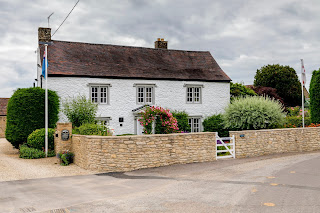Glebe Farm and the Harris Factory
Last year the owner of the house, Martin Robins, wrote to Calne Heritage Centre because he thought we would be interested to know that the wall around his front garden was built from stone reclaimed from the demolition of the C&T Harris factory in Calne.
We have kept in touch since then and Martin sends us photos and snippets of information now and then. Here is the story of Martin’s wall in his own words.
“Originally in front of the house there was a natural stone wall constructed from ashlar [sawn block] stone about 2ft high. Sitting on the wall were railings but war-time regulations took them away.
In the early 1980s some conifer trees were planted and lo and behold, 30 years later they were huge. The house was dark and it took my wife and myself [mainly my wife] a fortnight every year to trim them. Enough was enough and four years ago out they came- with no small difficulty. One root still exists.
 Enter “Last of the
Summer Wine”- three old boys, myself labouring, a retired joiner [late 70s] and
a retired bricklayer [late 60s]. I knew a builder in Malmesbury had a lock- up
in a village and within was beautifully weathered stone, similar to bricks,
delivered from the C&T Harris demolition donkey’s years ago. If we were forced
to use freshly quarried stone it would look brash and out of sync with a
400-year-old house and would not weather for many years. The C&T Harris
stone was perfect- weathered and the right colour. It was also the right price.
Obtaining weathered building stone is nigh on impossible.
Enter “Last of the
Summer Wine”- three old boys, myself labouring, a retired joiner [late 70s] and
a retired bricklayer [late 60s]. I knew a builder in Malmesbury had a lock- up
in a village and within was beautifully weathered stone, similar to bricks,
delivered from the C&T Harris demolition donkey’s years ago. If we were forced
to use freshly quarried stone it would look brash and out of sync with a
400-year-old house and would not weather for many years. The C&T Harris
stone was perfect- weathered and the right colour. It was also the right price.
Obtaining weathered building stone is nigh on impossible.
Three weeks of very hard work, aching backs, worn-out wheelbarrows and the job was done. The house is lighter and the wall looks as if it has been in place forever. It cost about one tenth of the normal price, thanks to C&T Harris and three old boys.”
It is good to hear that stone from the Harris factory is being used and preserved in this way. Anyone looking at the photographs must agree with Martin that the warm-coloured, weathered stone compliments his house perfectly.
Sue Boddington.
Photo Credit: Martin Robins
